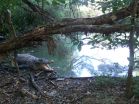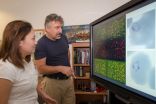(Press-News.org) The entire semiconductor industry, not to mention Silicon Valley, is built on the propensity of electrons in silicon to get kicked out of their atomic shells and become free. These mobile electrons are routed and switched though transistors, carrying the digital information that characterizes our age.
An international team of physicists and chemists based at the University of California, Berkeley, has for the first time taken snapshots of this ephemeral event using attosecond pulses of soft x-ray light lasting only a few billionths of a billionth of a second.
While earlier femtosecond lasers were unable to resolve the jump from the valence shell of the silicon atom across the band-gap into the conduction electron region, the new experiments now show that this transition takes less than 450 attoseconds.
"Though this excitation step is too fast for traditional experiments, our novel technique allowed us to record individual snapshots that can be composed into a 'movie' revealing the timing sequence of the process," explains Stephen Leone, UC Berkeley professor of chemistry and physics.
Leone, his UC Berkeley colleagues and collaborators from the Ludwig-Maximilians Universität in Munich, Germany, the University of Tsukuba, Japan, and the Molecular Foundry at the Department of Energy's Lawrence Berkeley National Laboratory report their achievement in the Dec. 12 issue of the journal Science.
Century-old discovery observed
Leone notes that more than a century has elapsed since the discovery that light can make certain materials conductive. The first movie of this transition follows the excitation of electrons across the band-gap in silicon with the help of attosecond extreme ultraviolet (XUV) spectroscopy, developed in the Attosecond Physics Laboratory run by Leone and Daniel Neumark, UC Berkeley professor of chemistry.
In semiconducting materials, electrons are initially localized around the individual atoms forming the crystal and thus cannot move or contribute to electrical currents. When light hits these materials or a voltage is applied, some of the electrons absorb energy and get excited into mobile states in which the electrons can move through the material. The localized electrons take a "quantum jump" into the conduction band, tunneling through the barrier that normally keeps them bound to atoms.
These mobile electrons make the semiconductor material conductive so that an applied voltage results in a flowing current. This behavior allows engineers to make silicon switches, known as transistors, which have become the basis of all digital electronics.
The researchers used attosecond XUV spectroscopy like an attosecond stop watch to follow the electron's transition. They exposed a silicon crystal to ultrashort flashes of visible light emitted by a laser source. The subsequent illumination with x-ray-pulses of only a few tens of attoseconds (10-18 seconds) in duration allowed the researchers to take snapshots of the evolution of the excitation process triggered by the laser pulses.
Unambiguous interpretation of the experimental data was facilitated by a series of supercomputer simulations carried out by researchers at the University of Tsukuba and the Molecular Foundry. The simulations modeled both the excitation process and the subsequent interaction of x-ray pulses with the silicon crystal.
Electron jump makes atoms rebound
The excitation of a semiconductor with light is traditionally conceived as a process involving two distinct events. First, the electrons absorb light and get excited. Afterwards, the lattice, composed of the individual atoms in the crystal, rearranges in response to this redistribution of electrons, turning part of the absorbed energy into heat carried by vibrational waves called phonons.
In analyzing their data, the team found clear indications that this hypothesis is true. They showed that initially, only the electrons react to the impinging light while the atomic lattice remains unaffected. Long after the excitation laser pulse has left the sample - some 60 femtoseconds later - they observed the onset of a collective movement of the atoms, that is, phonons. This is near the 64 femtosecond period of the fastest lattice vibrations.
Based on current theory, the researchers calculated that the lattice spacing rebounded about 6 picometers (10-12 meters) as a result of the electron jump, consistent with other estimates.
"These results represent a clean example of attosecond science applied to a complex and fundamentally important system," Neumark says.
The unprecedented temporal resolution of this attosecond technology will allow scientists to resolve extremely brief electronic processes in solids that to date seemed too fast to be approached experimentally, says Martin Schultze, who was a guest researcher in Leone's lab last year, visiting from the Ludwig-Maximilians Universität München. This poses new challenges to the theory of light-matter interactions, including the excitation step, its timescale and the interpretation of experimental x-ray spectra.
"But here is also an advantage," Schultze adds. "With our ultrashort excitation and probing pulses, the atoms in the crystal can be considered frozen during the interaction. That eases the theoretical treatment a lot."
INFORMATION:
Other coauthors are Krupa Ramasesha, D. Whitmore, A. Gandman, James S. Prell and L. J. Borja of UC Berkeley; C.D. Pemmaraju and D. Prendergast of the Molecular Foundry; and S.A. Sato and K. Yabana of Tsukuba.
The work was funded by the U.S. Department of Defense and the Defense Advanced Research Projects Agency's PULSE program. Supercomputing resources were provided by Lawrence Berkeley National Laboratory, the National Energy Research Scientific Computing Center (NERSC) and the Institute of Solid State Physics, University of Tokyo.
CHAMPAIGN, Ill. - Where did the songbird get its song? What branch of the bird family tree is closer to the flamingo - the heron or the sparrow?
These questions seem simple, but are actually difficult for geneticists to answer. A new, sophisticated statistical technique developed by researchers at the University of Illinois and the University of Texas at Austin can help researchers construct more accurate species trees detailing the lineage of genes and the relationships between species.
The method, called statistical binning, was used in the Avian Phylogenetics Project, ...
This news release is available in Spanish. 66 million years ago, the dinosaurs, as we think about them, became extinct, but certain reptiles and birds survived this mass extinction. The birds that survived experienced rapid evolution and diversification. Until now, explaining the family tree of modern birds has been a difficult and controversial subject amongst scientists. Thanks to the research of an international consortium involving researchers from the Centre for Genomic Regulation in Barcelona, we now have new clues about this evolution and further information ...
FORT LAUDERDALE-DAVIE, Fla. - We all know that ducks, crows, falcons and egrets are birds. A group of scientists, however, wanted to dig deeper and unlock more about how these animals are related genetically. The idea was to investigate how modern species of birds emerged and evolved after the dinosaurs disappeared from the earth. This research included work from Stephen O'Brien, Ph.D., a professor at NSU's Oceanographic Center whose main focus in genomics.
Now findings from this research are being announced in several scientific publications, including Science magazine, ...
A Texas Tech University biologist led a team of more than 50 scientists who mapped the genomes of three crocodilians.
By mapping these genomes, scientists may better understand the evolution of birds, which are the toothy predators' closest living relatives, said David Ray, an associate professor of biology. The team completed genomes of a crocodile, an alligator and a true gharial to complete the genomic family portrait.
Their research, largely funded by the National Science Foundation, will appear Friday (Dec. 12) in the peer-reviewed journal, Science.
"One of the ...
Scientists from Nanyang Technological University (NTU) have discovered exactly how the malaria parasite is developing resistance towards the most important front-line drugs used to treat the disease.
Malaria is a mosquito-borne parasite which affects over 60 million people worldwide and in serious cases, can be fatal. There is currently no viable vaccine for malaria while antimalarial drugs and prophylaxis are losing its efficacy with increasing drug resistance.
NTU Associate Professor Zbynek Bozdech, who led an international research team from 11 different countries, ...
The first findings of the Avian Phylogenomics Consortium are being reported nearly simultaneously in 28 papers -- eight papers in a Dec. 12 special issue of Science and 20 more in Genome Biology, GigaScience and other journals. The full set of papers in Science and other journals can be accessed at avian.genomics.cn
Scientists already knew that the birds who survived the mass extinction experienced a rapid burst of evolution. But the family tree of modern birds has confused biologists for centuries and the molecular details of how birds arrived at the spectacular biodiversity ...
New research from the University of Kent suggests that chickens and turkeys have experienced fewer gross genomic changes than other birds as they evolved from their dinosaur ancestor.
Professor Darren Griffin and a team at the University's School of Biosciences have conducted research that suggests that chromosomes of the chicken and turkey lineage have undergone the fewest number of changes compared to their ancient avian ancestor, thought to be a feathered dinosaur.
The Kent research is part of a study by a consortium of leading scientists into avian or bird genomes, ...
An international team of scientists has completed the largest whole genome study of a single class of animals to date. To map the tree of life for birds, the team sequenced, assembled and compared full genomes of 48 bird species representing all major branches of modern birds including ostrich, hummingbird, crow, duck, falcon, parrot, crane, ibis, woodpecker and eagle species. The researchers have been working on this ambitious genetic tree of life, or phylogeny, project for four years.
As part of the Avian Phylogenomics Consortium -- comprised of more than 200 scientists ...
NEW YORK, NY (December 11, 2014) Growing resistance to malaria drugs in Southeast Asia is caused by a single mutated gene inside the disease-causing Plasmodium falciparum parasite, according to a study led by David Fidock, PhD, professor of microbiology & immunology and of medical sciences (in medicine) at Columbia University Medical Center.
This finding provides public health officials around the world with a way to look for pockets of emerging resistance and potentially eliminate them before they spread.
Though malaria deaths have dropped by 30 percent worldwide since ...
Targeted therapies are a growing and groundbreaking field in cancer care in which drugs or other substances are designed to interfere with genes or molecules that control the growth and survival of cancer cells. Now, scientists at Virginia Commonwealth University Massey Cancer Center and VCU Institute of Molecular Medicine (VIMM) have identified a novel interaction between a microRNA and a gene that could lead to new therapies for the most common and deadly form of brain tumor, malignant glioma.
In a study recently published in the journal Neuro-Oncology, a team of scientists ...


